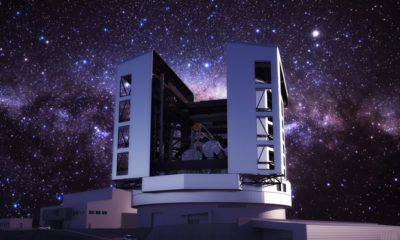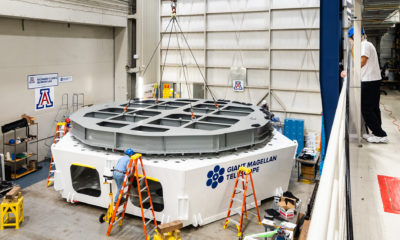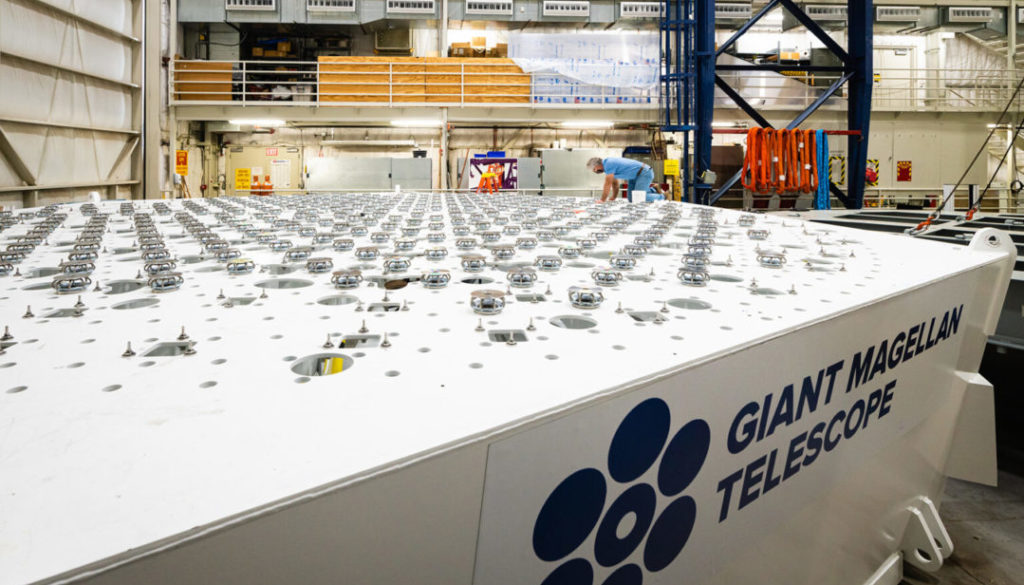Major NSF Grant Accelerates Development of Giant Magellan Telescope
The GMTO Corporation, the organization managing the development of the Giant Magellan Telescope (GMT) on behalf of its US and international founders including Texas A&M University, has received a $17.5 million grant from the National Science Foundation (NSF) to accelerate prototyping and testing of some of the most powerful optical and infrared technologies ever engineered as the GMT’s underpinning.
These crucial advancements for the GMT, currently under construction at Las Campanas Observatory in Chile, will allow astronomers to see father into space with more detail than with any previous optical telescope. The NSF grant also positions the GMT to be one of the first in a new generation of large telescopes that are approximately three times the size of any ground-based optical telescope built to date.
The GMT, along with the Thirty Meter Telescope (TMT), is part of the US Extremely Large Telescope Program, a joint initiative with NSF’s National Optical-Infrared Astronomy Research Laboratory to provide unprecedentedly superior observing access to the entire sky. Upon completion of each telescope, US scientists and international partners will be able to take advantage of the program’s two pioneering telescopes to carry out transformational research that answers some of humanity’s most pressing questions, such as, are we alone in the universe, and where did we come from?
“We are honored to receive our first NSF grant,” said GMTO President Dr. Robert N. Shelton. “It is a giant step toward realizing the GMT’s scientific goals and the profound impact the GMT will have on the future of human knowledge.”

One of the great challenges of engineering revolutionary technologies is constructing them to operate at optimal performance. The GMT is designed to have a resolving power 10 times greater than the Hubble Space Telescope — one of the most productive scientific achievements in the history of astronomy. This advancement in image quality is a prerequisite for the GMT to fully realize its scientific potential and expand our knowledge of the universe.
“Image quality on any telescope starts with the primary mirror,” said GMTO Project Manager Dr. James Fanson. “The Giant Magellan Telescope’s primary mirror comprises seven 8.4-meter mirror segments. To achieve diffraction-limited imaging, we have to be able to phase these primary mirror segments so that they behave as a monolithic mirror. Once phased, we must then correct for Earth’s turbulent atmospheric distortion.”
Phasing involves precisely aligning a telescope’s segmented mirrors and other optical components so that they work in unison to produce crisp images of deep space. Achieving this with seven of the world’s largest mirrors ever built is no easy task. The immense size of the GMT’s primary mirror requires a powerful adaptive optics system to correct for the blurring effects of the Earth’s atmospheric turbulence at kilohertz speeds. In other words, astronomers need to take the subtle “twinkle” out of the stars in order to capture high-resolution data from celestial objects thousands of light-years from our planet.

The NSF grant enables the GMT to build two phasing testbeds that will allow engineers to demonstrate within a controlled laboratory setting that the telescope’s core designs will work to align and phase its seven mirror segments with the required precision to achieve diffraction-limited imaging at first light in 2029. These testbeds will be developed at the University of Arizona Center for Astronomical Adaptive Optics and the Smithsonian Astrophysical Observatory, while actuator testing and integration of the primary mirror support will be developed at Texas A&M University.
“We are working on a key element of that system in the Munnerlyn Lab — hundreds of pneumatic pistons that hold up the primary mirror and help keep it in the correct figure,” said Texas A&M astronomer Dr. Darren L. DePoy. “The curvature has to be precise to roughly a one-quarter wavelength of light. We have dozens of students working on building and testing these pistons, also known as actuators.”
Munnerlyn Lab researchers have been working in collaboration with the GMT engineering group to develop assembly and test procedures for each air cylinder as well as for integrating them into either single- or triple-actuator castings. DePoy says his team has completed more than 60 air cylinders to date and currently is manufacturing parts for hundreds more. Once completed, all the actuators are shipped to the University of Arizona to be installed in the primary mirror test cell.
The NSF grant also enables the partial build and testing of a next-generation Adaptive Secondary Mirror (ASM), which is used to perform the primary mirror phasing and atmospheric distortion correction. This work will be developed in contract with AdOptica.
“Our seven Adaptive Secondary Mirrors take this technology to the next step,” Fanson said. “No one has attempted to use seven ASMs before the Giant Magellan Telescope. They are probably the most advanced tech we have on the telescope, and their success is a top priority. We need to test and validate their performance early on in the project.”
Astronomers will use the GMT’s high-fidelity adaptive mirrors and other revolutionary adaptive optics technologies to detect faint biosignatures from distant exoplanets — one of the GMT’s primary scientific goals.
This work is part of a larger $23 million joint-award to the Association of Universities for Research in Astronomy (AURA) and the GMT over the next three years. The GMT project is the work of a distinguished international consortium of leading universities and science institutions.
For more information on the Giant Magellan Telescope, visit www.gmto.org.
To learn more about the Munnerlyn Astronomical Instrumentation Laboratory and related projects, go to https://instrumentation.tamu.edu/.
# # # # # # # # # #
About the Giant Magellan Telescope: The Giant Magellan Telescope is a next-generation ground-based telescope that promises to revolutionize our understanding and view of the universe. The GMT is poised to enable breakthrough discoveries in cosmology, the study of black holes, dark matter, dark energy, and the search for life beyond our solar system. The telescope’s primary mirror combines seven 8.4-meter (27 feet) diameter circular segments to form an effective aperture 24.5 meters in diameter. The GMT will be located at Las Campanas Observatory in Chile’s Atacama Desert, and the project is the work of a distinguished international consortium of leading universities and science institutions. Funding for the project comes from the partner institutions, governments and private donors.
About Research at Texas A&M University: As one of the world’s leading research institutions, Texas A&M is at the forefront in making significant contributions to scholarship and discovery, including that of science and technology. Research conducted at Texas A&M represented annual expenditures of more than $952 million in fiscal year 2019. Texas A&M ranked in the top 20 of the National Science Foundation’s most recent Higher Education Research and Development survey (2018), based on expenditures of more than $922 million in fiscal year 2018. Texas A&M’s research creates new knowledge that provides basic, fundamental and applied contributions resulting, in many cases, in economic benefits to the state, nation and world. To learn more, visit Research@Texas A&M.
-aTm-
Contact: Shana K. Hutchins, (979) 862-1237 or shutchins@science.tamu.edu or Dr. Darren L. DePoy, (979) 862-2082 or depoy@tamu.edu
The post Major NSF Grant Accelerates Development of Giant Magellan Telescope appeared first on Texas A&M College of Science.
